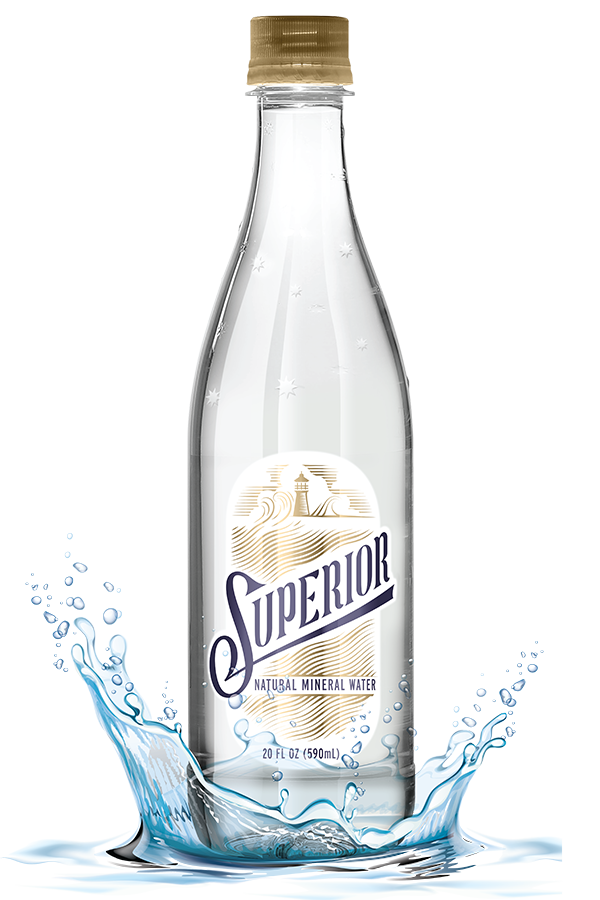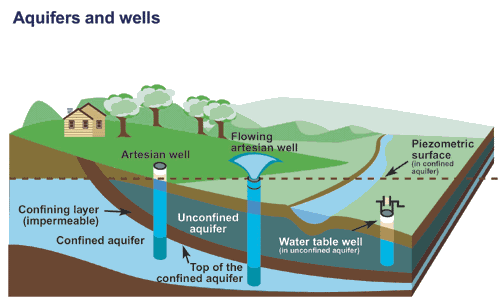As dedicated protectors of the environment we are focused on maximizing every resource we can. We are constantly amazed at how much we all take water for granted. In the United States, we have an amazing system for keeping clean, potable water flowing and managing wastewater better than most places in the world. If you have ever traveled overseas (or even to our southern neighbor) you may be familiar with issues that can be caused by drinking water that is not cleaned as rigorously as in our own country.
But, the basics of water are pretty simple – and the cycle is something of a closed loop. In this post, we will share some of the more basic things that happen to create our water (we introduce the concept of an Aquifer to the basic cycle) and share some of the other, more complex pieces, of our overall water economy.
What is an Aquifer?
An aquifer is defined as an array of permeable rock and other substrates through which precipitating water flows that both cleans and adds minerals to the water. Essentially, the Earth acts as a filter and storage house for water in all sorts of forms. See the image below and follow the link to the Wikipedia page on Aquifers for a bit more detail.
https://en.wikipedia.org/wiki/Aquifer
The next big question is…Is all water from an aquifer as good as Superior Natural Mineral Water? The short answer is not – the quality of any mineral water depends on the style and location of the aquifer in question. Our aquifer, located in the Ottawa National Forest, is one of the finest aquifers anywhere in the world and produces a water that is great tasting and has many health benefits. If you are familiar with Lake Superior then you are familiar with the area where our aquifer exists. As a matter of fact, there are multiple aquifers around Lake Superior but none of them produce the same style and flavor of water.
The perfect mineral water is a result of have the right substrates, the right protection and the never-ending cycle of Hydrogeology – or what makes our water unique.
What is the Basic Water Cycle?
This one is very straightforward – there are three steps in the basic water cycle:
- Evaporation – heat and light cause water to turn from a liquid to a gas and move up into the atmosphere
- Condensation – once there, the cooling nature of higher altitudes condenses water out of the moist air to create clouds
- Precipitation – once the clouds get full (saturated) the distribute the water they contain in the form of precipitation (a very important word for rain)
That is not too involved – but the above leaves out a lot. The link below will take you to the National Oceanic and Atmospheric Administration (NOAA) web site where they explain in-depth about the total cycle. Suffice it to say, the process is more complex and takes longer than the above basic cycle would suggest. Here, we will share a few of the cooler steps (sorry – we think water is pretty cool):
- Sublimation – this takes place in the very cold (usually) and is when solid matter (ice/snow) turns directly into water vapor without ever hitting the liquid phase. Think Dry Ice – it does not melt by evaporates
- Percolation – this is near and dear to our hearts as it is the basis of an aquifer. Groundwater gets absorbed into the soil and “percolates” through substrate layers getting purified and picking up those natural minerals and nutrients
- Transpiration – this is where water that is contained in plants gets absorbed back into the atmosphere. Similar to evaporation, think of it as plant sweat!
- Deposition – remember sublimation? Well, this is the opposite when water vapor turns directly into a solid without going through a liquid phase. Deposition of water can also refer to how water interacts with soil to create a slurry that carries some of the soil with it and deposits it elsewhere
Okay, you can get your geek on by checking out the NOAA web site…
https://www.noaa.gov/education/resource-collections/freshwater/water-cycle
Why Are Water Cycles Important?
As one of the most abundant and precious resources we have, the Water Cycle(s) are critical to survival through the creation of access to water. The entire process can take years – especially to create and maintain a quality aquifer like the one we use. Not to worry – we work with the city of Marenisco and various government agencies to make sure we take less water from the aquifer than is produced through the entire water cycle. Unlike some companies and municipalities, we exist to make sure we do no harm to the environment around us – through every step of our process.
We also encourage everyone to do their part to conserve water. Here are some simple tips you can do everyday:
- When brushing your teeth, turn off the water while you brush. Many folks let the water run and this allows good, potable water to simply run down the drain. Teach your kids good habits like this when they learn to brush and they will help keep things safe for their grandkids!
- Focus on prairie grass or gardens rather than traditional grass where you can. Traditional grass requires a lot more water per square foot than native prairie grasses. We have to unlearn the desire for a perfectly manicured lawn – that beauty costs a lot of resources.
- Be mindful – think about how you use water and create a conservation plan for your family. This could mean washing your cars less often or using the natural contours of the land to water more plants or using captured rainwater as you main source of garden watering (ask us sometime about our friends “Water Butt” – he is English and that should be a hint at what he is doing…).
Closing Thought: Check out the image of the Lake Superior region for a bit of info on what makes up our aquifer and the aquifers around us.
Fun Fact: Did you know that Southern California has to import almost all of their water? So little rain falls and so little freshwater exists in groundwater or aquifers that the lower third of California gets their water from Northern California (drought conditions, like in 2020-2021 sometimes make this more difficult) and from places like Arizona and Nevada. They even try and purchase water from places like Minnesota and Michigan – and usually do not have much luck!

